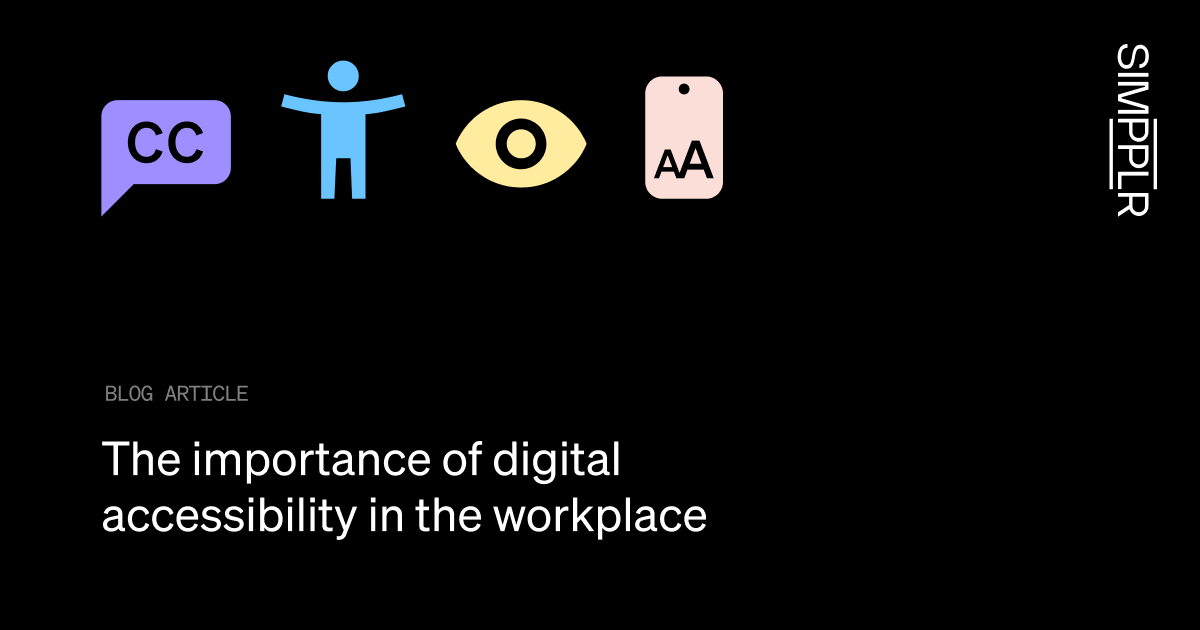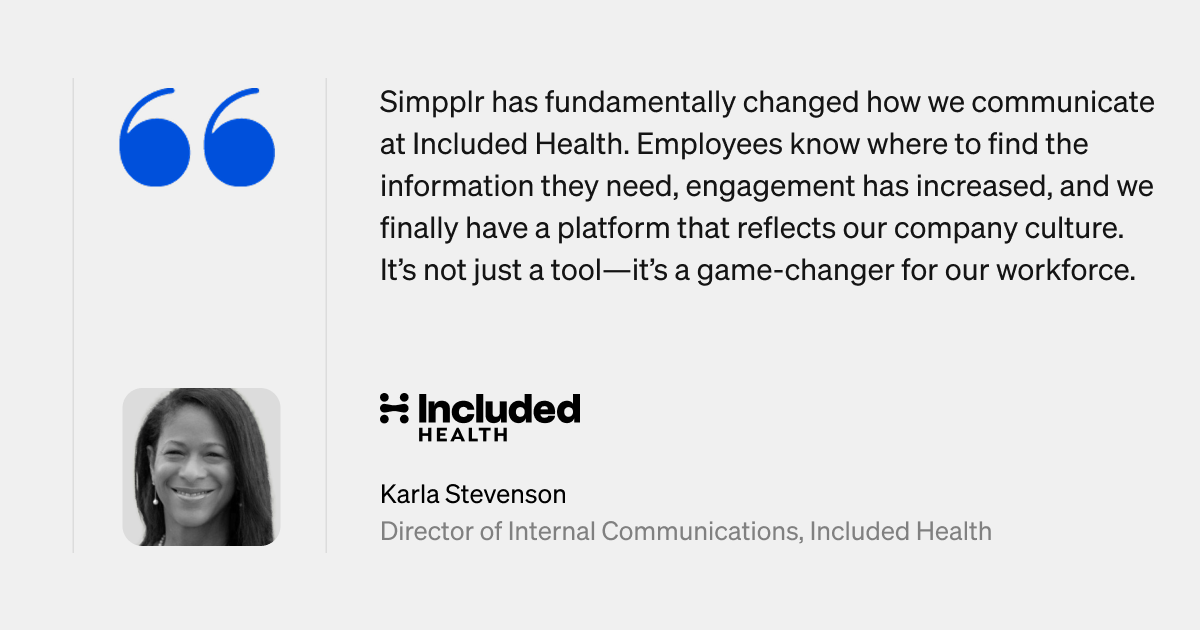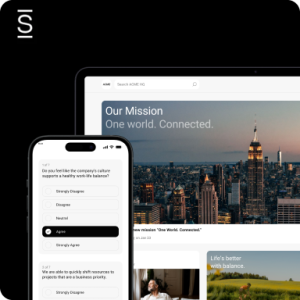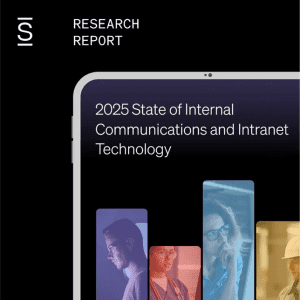Poor internal communication in healthcare can mean the difference between life and death. Healthcare workers need specialized communication systems that match their mobile, 24/7 work environment. The right healthcare employee communication strategies connect everyone from surgeons to overnight staff, ultimately improving patient safety, care coordination, and staff morale.

7 steps to improve healthcare employee communication
- 1 Assess your current healthcare employee communications
- 2 Define communication standards and governance
- 3 Deploy a modern healthcare intranet platform
- 4 Enable mobile-first healthcare employee communication
- 5 Centralize internal communication channels
- 6 Foster cross-departmental collaboration via digital workspaces
- 7 Build employee engagement through recognition and feedback
- 8 Continuous improvement and ongoing considerations
- 9 Simpplr improves healthcare employee communication
Failures in healthcare employee communication carry consequences that extend far beyond inconvenience. In 2022, The Joint Commission reviewed 1,441 sentinel events and identified communication failures, along with teamwork breakdowns and policy noncompliance, as the main drivers of serious patient safety incidents.
Traditional communication approaches weren’t designed for the modern healthcare industry. Email works well for desk-based professionals who can dedicate time to sorting through messages, but it fails shift workers who need information immediately and lack consistent computer access. Bulletin boards and printed memos might reach staff in break rooms, but they can’t deliver urgent updates to dispersed teams in real time.
These one-way communication channels also leave staff feeling unheard, with no mechanism to provide feedback, ask questions, or contribute their frontline insights.
The following seven strategies for healthcare employee communication show you how to create a unified, accessible, and engaging internal communications ecosystem that serves everyone — from executive leadership to overnight custodial staff.

1. Assess your current healthcare employee communications
Before implementing new tools or overhauling your communication strategy, this assessment phase is critical. Skipping it leads to expensive technology deployments that don’t actually solve the problems your staff faces every day.
Identify communication breakdowns
Start by pinpointing where information gets lost in your organization, such as in shift changes, departmental handoffs, or policy rollouts.
Ask yourself questions such as:
- Which staff groups consistently feel disconnected or uninformed, particularly people working nights, weekends, or per diem shifts?
- What critical information takes too long to reach patient-facing workers?
- Where have communication failures led to near misses, delays in care, duplicated efforts, or staff frustration?
Track specific incidents and patterns rather than making assumptions about how communication should work.
Survey staff across all roles and shifts
Anonymous feedback is essential for uncovering real communication pain points. Survey every role and every shift, asking specific, actionable questions rather than vague inquiries about satisfaction.
Consider questions such as:
- What tools do staff actually check and trust?
- Where do they go first when they need critical information?
- What communication patterns frustrate them most?
- How much time do they spend searching for information versus having it readily available?
Understanding the vastly different needs of patient-facing employees versus desk-based employees is crucial. What works perfectly for HR staff in the administrative building won’t work for respiratory therapists moving between patient rooms all day.
Map information flows and gaps
Document every current communication channel and its stated purpose. This exercise typically reveals uncomfortable truths. You’ll likely discover that the same information appears in five different places, creating confusion about which source is authoritative and current. Or you’ll spot significant coverage gaps where entire shifts, departments, or facilities rarely receive important updates.

2. Define communication standards and governance
Without clear standards, even the most sophisticated healthcare staff communication tools devolve into chaos. Governance establishes the rules, processes, and accountability that make your internal communication ecosystem functional.
Categorize healthcare employee communication types
Not all messages carry equal importance or urgency, and treating all of them as equally urgent can turn into a sort of communications alarm fatigue.
Create clear categories that everyone in your organization understands and respects:
- Critical or urgent communications include safety alerts, emergency protocols, active threat situations, equipment failures affecting patient care, or immediate operational needs requiring instant attention.
- Important communications cover policy updates, schedule changes, mandatory training deadlines, quality initiatives, and departmental announcements that require timely attention but don’t constitute emergencies.
- General communications encompass company news, employee recognition, wellness program information, community events, and employee resources that staff can consume whenever convenient.
These categories help both message senders and receivers prioritize appropriately, ensuring vital updates don’t get lost in the noise.
Assign channels to communication types
Once you’ve established employee communication categories, assign each category to specific channels. Critical safety alerts might go through push notifications and the mobile app’s alert system. Important policy updates might be posted to the intranet, with targeted emails sent to managers to cascade the information to their teams. General company news could live in the employee hub where employees can browse when they have time.
Establish sender permissions and approval workflows
Determine who can send what to whom, preventing scenarios where five different people send five versions of the same policy update, or where every department manager can send push notifications at will. For sensitive or high-stakes information, establish consistent review processes.
Balance this necessary control by empowering department leaders to share pertinent information within their domains. Nurse managers should be able to update their units about schedule changes or process improvements without navigating byzantine approval processes, for example. The goal is appropriate governance and clinical communication improvement, not bureaucratic bottlenecks.
3. Deploy a modern healthcare intranet platform
A well-designed healthcare intranet serves as the backbone of healthcare employee communication, providing a centralized digital workplace where all employees access information and resources, connect with colleagues, and engage with the organization —all from wherever they’re working.
Centralized access to policies, procedures, and documents
The intranet should function as a single source of truth for everything from clinical guidelines to HR policies to operational workflows. When a nurse needs the current catheter insertion protocol or a new employee wants to understand PTO policies, they should know exactly where to look and find the information immediately. Attribute-based access ensures employees see content relevant to their responsibilities while maintaining compliance with information security requirements.
Robust enterprise search functionality is essential. Deskless workers might access the platform from a shared workstation during a quick break or from their personal phones between patient interactions. They shouldn’t have to spend 15 minutes navigating complicated folder structures.
Integrate employee news and announcements
Beyond static documents, a modern intranet can deliver dynamic news and announcements in ways that don’t overwhelm users. Targeted distribution allows you to send department-specific, location-specific, or role-specific news. Operating room staff see updates relevant to their work without wading through irrelevant cafeteria menu changes or parking lot updates for a different campus.
Push notifications deliver urgent alerts and critical updates, but they must be used sparingly, in accordance with hospital communication protocols, to maintain their effectiveness. Otherwise, employees might start ignoring all notifications, including truly critical ones.
A modern intranet reduces communication overload by consolidating information that previously arrived as dozens of separate messages across multiple systems. But the platform’s value extends beyond information access. The following sections explore how mobile capabilities, collaboration tools, and recognition features transform the intranet from a static repository into a dynamic employee experience platform.

4. Enable mobile-first healthcare employee communication
The majority of healthcare employees don’t sit at desks. Hospital internal communication best practices now emphasize mobile-first approaches that meet staff where they are.
A robust mobile application puts essential information and communication tools directly in every employee’s pocket. Real-time shift updates and schedule access eliminate the need for staff to call in or check physical posted schedules. Instant messaging and secure chat enable quick medical staff coordination.
These features must be HIPAA-compliant. Consumer messaging apps like WhatsApp or personal texting aren’t appropriate for healthcare employee communication that might reference patient information, even indirectly.
And the app should provide quick access to protocols, forms, training materials, and resources from any device, anywhere, anytime. A respiratory therapist can pull up the latest ventilator protocol from a patient’s bedside without leaving to find a computer. These healthcare employee communication tools reduce the time spent searching for information and increase the time spent on patient care.
To maximize its effectiveness, the apps your organization chooses must support multiple languages to reflect your diverse workforce. Accessibility features like screen readers and adjustable text sizes ensure that all employees can use the platform effectively.

5. Centralize internal communication channels
While email certainly has its place for certain types of communication, it shouldn’t be the primary or only channel for healthcare employee communication.
Unified digital work hubs for all internal communications
Replace scattered, easily-buried emails with channel-based announcements organized by topic, department, project, or initiative. Instead of everyone receiving every message, employees can follow channels relevant to their work and ignore those that aren’t. A labor and delivery nurse doesn’t need constant updates about the orthopedics department’s new protocols.
Consider adding discussion boards and Q&A communities to facilitate shared learning, where one person’s question and its answer benefit everyone facing similar challenges.
And integration with existing workplace systems means employees don’t need to constantly switch between platforms to find information. The hub can pull in or link to relevant content from your scheduling system, learning management system, HR system, or electronic health record.
Personalization for increased relevance
Personalized news feeds and alerts based on role, department, and location ensure employees see information relevant to them without drowning in irrelevant content. A dietary aide at your suburban campus doesn’t need constant updates about the downtown hospital’s parking garage construction project.
Allow subscription preferences for noncritical communications so employees can opt into optional information about wellness programs, social committees, or employee resource groups if they are interested.
Robust analytics on engagement and message reach show you what’s actually working versus what’s being ignored.
You can gain actionable insights on:
- Which announcements are actually being read
- Which channels have low engagement
- Where there are gaps in information delivery
This data informs continuous improvement of your communication strategy based on actual usage patterns rather than assumptions.

6. Foster cross-departmental collaboration via digital workspaces
Delivering excellent healthcare fundamentally depends on collaboration, but organizational silos often prevent effective teamwork across departments and disciplines. Digital workspaces break down these barriers and enable the interdisciplinary healthcare team collaboration that drives quality improvement, innovation, and operational excellence.
Virtual project spaces and communities
Create secure workspaces where interdisciplinary teams can collaborate on initiatives without the chaos of email threads involving dozens of people and scattered attachments. A quality improvement project involving physicians, nurses, pharmacy staff, and administrators needs a central place for document co-authoring, project tracking, and discussion.
These digital workspaces support clinical information sharing and best practice exchange, allowing successful initiatives from one department, unit, or location to spread efficiently throughout the organization.
Communities of practice bring together people with similar roles or interests across the entire organization. All the nurse educators can connect and share resources. All the respiratory therapists can troubleshoot challenges together. Everyone involved in patient experience initiatives can collaborate regardless of which department they work in.
These communities foster connection and healthcare information flow that wouldn’t happen organically, given the physical and schedule separation of healthcare workers.
Streamline cross-functional projects
Central dashboards give visibility to department initiatives and organizational priorities, helping everyone understand how their specific work connects to larger strategic goals. Real-time updates on project status and milestones keep everyone aligned without endless status meetings that pull clinical staff away from patient care.
Shared workflows for quality improvement and operational excellence initiatives create consistency in how projects are executed while still allowing customization for specific departmental needs.
When everyone can see what everyone else is working on, you reduce duplicated efforts where two departments unknowingly tackle the same problem separately. You also create opportunities for synergy where related initiatives can coordinate for greater impact.
7. Build employee engagement through recognition and feedback
Recognition and rewards transform your communication platform from a mere information delivery system into a genuine community where people feel valued and appreciated. Peer nomination and recognition tools make it easy and natural for employees to acknowledge each other’s contributions in the moment.
Public recognition of achievements reinforces your organization’s values, like excellent patient outcomes, innovative problem-solving, or exceptional care under pressure.
Be sure to celebrate nonclinical contributions like mentoring new staff, improving processes, or going above and beyond to help colleagues. Milestone moments are another opportunity to highlight employees. Work anniversaries, professional certifications, completed degrees, and retirements help employees feel valued as whole people, not just workers. Personal recognition from leadership carries particular weight.
Create dialogue and gather employee feedback
Employee feedback channels give staff a voice beyond their immediate manager. When a patient-facing worker has an idea for improving a workflow or spots a potential safety concern, they need an easy, accessible way to share it with decision-makers.
The best ideas for operational improvements typically come from the people doing the work every day, but those insights often get trapped without mechanisms to communicate them.
Pulse surveys allow leadership to gather quick feedback on specific questions:
- How’s the new scheduling system working?
- What’s your biggest operational challenge this week?
- What would make your job easier?
Regular engagement surveys within the intranet platform, rather than through separate survey tools, increase participation and allow you to track sentiment over time. You can identify concerning trends early and respond before small problems become major issues affecting retention and morale.But the most critical element is transparent follow-up. Employees need to see that their feedback matters and influences decisions. Without visible follow-through, even the best feedback systems become worse than useless — they actively damage trust by creating the perception that leadership asks for input but doesn’t actually care about the responses.

Continuous improvement and ongoing considerations
Implementing these seven strategies isn’t a one-time project. The most successful organizations treat internal communication as an ongoing practice requiring continuous attention, not a problem to solve once and check off the list.
This ongoing approach requires:
- Consistent measurement through engagement analytics and operational outcomes
- Responsive feedback loops that surface problems and opportunities quickly, allowing you to make adjustments before small issues snowball
- Genuine organizational willingness to adapt strategies based on what you learn through measurement and feedback
Security and compliance considerations must be woven throughout both implementation and ongoing management: HIPAA-compliant messaging, end-to-end encryption, and structured access rights aren’t optional or negotiable for any medical communication technology handling healthcare data.
But how do you know if your new communication strategies are actually working, or just creating different problems? Measurement must be built into your approach from the beginning, tracking both usage metrics and real-world outcomes that matter for your organization and your staff.
Measure success and maintain momentum
Track engagement metrics like intranet platform usage rates, content views, and participation in discussions, surveys, and recognition activities. Monitor operational outcomes such as time-to-find-information, policy compliance rates, and incident reports related to communication failures. Survey employees regularly about communication satisfaction and effectiveness.
Analytics dashboards surface patterns that aren’t visible from anecdotal feedback alone. You might discover that night shift staff rarely access the platform, that certain departments consistently ignore policy updates, or that specific content formats drive higher engagement. These insights help you identify gaps, adjust your communication strategy, and target interventions where they’re needed most.Finally, celebrate measurable wins and share success stories. When you can demonstrate that the new system actually improves people’s work lives — finding critical information faster, feeling more connected to a team, spending less time on administrative tasks — adoption accelerates organically.

Implement your intranet solution
Begin with an honest assessment and invest the time to discover your actual communication breakdowns before jumping to solutions. Prioritize mobile access because your frontline staff can’t wait for desktop-only solutions. And remember that technology enables communication, but culture and strategy make it effective.
This actionable plan will help your organization to honestly evaluate, select, and deploy a modern communication platform that enables your deskless and frontline employees.
Implementation roadmap
Start with quick wins in your first 30-60 days: Conduct an employee survey to understand current pain points and priorities, complete the communication audit mapping current flows and gaps, and develop the governance framework defining standards and responsibilities.
In the 60-120 day timeframe, tackle foundation building: Select and deploy your platform, roll out mobile access, and migrate critical content to the new system. Focus on making the platform functional and accessible before worrying about advanced features or achieving perfect content organization.
Optimization is an ongoing process throughout this roadmap and beyond:
- Launch engagement initiatives to build adoption and participation
- Roll out collaboration features as teams become comfortable with basic functionality
- Schedule regular analytics reviews to assess what’s working well and what needs adjustment
This phase is about continuous refinement and thoughtful expansion, not wholesale changes that confuse users.

Simpplr improves healthcare employee communication
Simpplr’s AI-powered healthcare employee communication platform addresses these challenges with features designed specifically for a mobile, 24/7 workforce. The platform combines the communication strategies outlined above into a unified solution.
Reach every employee, everywhere
Simpplr’s mobile-first platform is specifically designed for patient-facing workers. Push notifications for urgent updates ensure that critical information reaches every employee immediately, regardless of their location, shift, or role. Employees can access the platform from any device — personal smartphones, shared tablets at nursing stations, or desktop computers in administrative areas — ensuring that night and weekend staff aren’t left disconnected.
Centralize communication and reduce email overload
Simpplr creates a unified employee hub where all organizational communication lives in one intuitive, accessible place. Attribute-based, personalized content ensures employees see information relevant to them without drowning in irrelevant messages. Powerful search functionality means finding last month’s policy update takes seconds, not twenty minutes of searching through email archives or multiple disconnected systems.
Drive healthcare employee engagement
Built-in recognition tools make peer-to-peer and leadership acknowledgment seamless and meaningful. Two-way communication features give employees a genuine voice. Real-time analytics show exactly how your communication is performing — what’s being read, what’s being ignored, and where gaps exist — allowing for data-driven optimization.
Maintain compliance and security
Simpplr provides HIPAA-compliant messaging with audience-based access controls that protect information without sacrificing usability. Comprehensive audit trails support compliance requirements, giving you full visibility into information access patterns. You don’t have to choose between effective communication and regulatory compliance.
Ready to improve healthcare employee communication at your organization? Request a demo today.

Watch a 5-minute demo
See how the Simpplr employee experience platform connects, engages and empowers your workforce.
- #1 Leader in the Gartner Magic Quadrant™
- 90%+ Employee adoption rate













